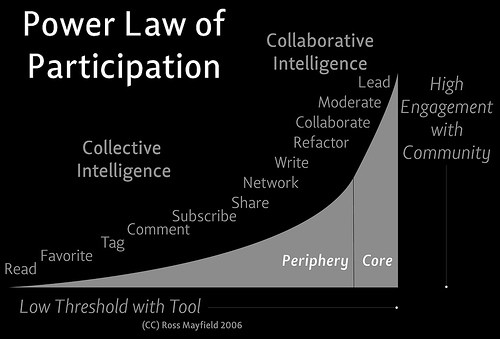Reasons To Be Optimistic During The Disruption Of Publishing
Sometimes we can get so caught up in what we’ve lost that we don’t see what we’ve gained. We fail to see the opportunities right in front of us because we’re focused on the qualities of a system that we find exploitative or antithetical to our values.

How can we accept the decline of newspapers and magazines, and the quality journalism therein, or accept the exploitation of writers? How can we retain valuable reporting, which requires payment?
One of the limitations of my talk was that it focused primarily on the history of book authorship and creative writing, more so than the fortunes of newspaper and magazine publishing or freelance journalists. I consider writing for hire (freelancing and journalism) quite different than creative writing (novels, memoir, etc), because the former necessarily has to pay attention to marketplace concerns, and if not, be gifted into existence or sustainability by patrons, grants, fellowships, and so on.
Journalists don’t typically expect—or shouldn’t expect—to make a living from their work by just writing what they want and disregarding the market. A creative writer, on the other hand, is usually assumed to be focusing on his art and mostly disregarding trends, though what he writes is of course influenced by what can be sold. For instance, short stories once could bring a writer decent pay, as it did F. Scott Fitzgerald, but one is quite lucky to earn any money from short fiction today. And serials could be very profitable for Dickens during the Victorian Era, but the form later fell out of favor for long fiction. (And serials may now be making a comeback because of their suitability for mobile distribution and consumption.)
Nevertheless: Too often we equate content with its container. For much of our lives, quality journalism has appeared in newspapers and magazines, so we equate the decline of that particular industry with the decline of journalism. But the survival of quality writing or journalism is not tied to the future of the newspaper or magazine business. Those are delivery and distribution mechanisms, they are services to readers, and they have become less useful and valuable to us in the digital era.
The challenge, of course, is that we know how to monetize a print newspaper or magazine—and it’s easier to charge for their perceived value. We’re still figuring out how to monetize digital forms. But amidst this challenge, I’d argue we’re not seeing less quality journalism today, we’re seeing more, because we have no distribution barriers and low start-up costs in digital publishing. I’d also ask if we really think the system pre-Internet was producing quality journalism, or if we merely prefer the devil we know. In the mid-20th century, media began to be operated by handful of conglomerates with significant control over the mass mediums of radio, TV, newspapers and magazines, a system that was hard for outside voices to access. To be sure, these major media conglomerates are being disrupted by another set of powerhouses (Google, Apple, Amazon, Facebook), but the latter provide us possibilities that didn’t exist before: the ability to directly reach a specific, targeted readership and gather a community, which can lead to monetization by individuals and businesses alike.
How long does it take to reach sustainability? It depends on what kind of community you’ve established and if you offer a compelling value they find deserving of their dollars. Let’s look at a few examples of people or institutions experimenting and succeeding in the digital era.
Brain Pickings
In 2006, Maria Popova started her site Brain Pickings, which is a catalogue of “interestingness.” Today, her work reaches millions through her website and email newsletter, and it’s sustainable through donations and affiliate marketing (more on that below). I recommend watching her talk at Tools of Change, where she discusses how journalism can sustain itself in the future. Popova is clearly doing what she loves, and has found a business model to serve her art.
The Information
Launched last fall, The Information is a subscription-based digital publication that costs $399 per year. It’s focused on a niche market, the technology business audience. What is the value or benefit to readers? High-quality stories and journalism that can be trusted (unlike much online content in the tech industry), and an implicit promise that you, the reader, are getting the smartest viewpoints and insights—in a very efficient way, I might add. You don’t have to filter through the noise of the many tech journalism sites to figure out what’s important.
Stratechery, Ben Thompson
Thompson just recently began a monetization effort for his insightful tech industry blogthat offers incentives for people to become members. Those incentives include: the ability to comment on articles, direct email access to Thompson, daily updates, virtual and in-person meet ups, and a private online community.
This website offers high-quality product reviews, mainly in the tech/media product space, and sustains itself through affiliate marketing.
Chris Guillebeau
An author and world traveler, Chris’s brand centers on the art of nonconformity, and I often recommend writers read his 279 Days to Overnight Success, which details how he made his website and blog a sustainable living in just under a year. He makes money from selling his own digital products and traditionally published books, as well as producing events.
And of course you also have the big guns, Andrew Sullivan and Nate Silver, but they are so often pulled out as models that I won’t belabor their trajectories here. I should also point out there are many valuable digital-era operations that give us plenty to be optimistic about when it comes to the future of journalism, such as ProPublica, a nonprofit, and the Pacific Standard, another nonprofit run out of the Miller-McCune Center for Research, Media and Public Policy. (In my mind, nonprofits and for-profits face the same issues of sustainability and have the same challenge of balancing art and business.)
Regarding payment for writers: When The Atlantic Online got in trouble last year for offering Nate Thayer $0 to re-post an article, Alexis Madrigal wrote a very long response about how and why freelancers were offered so little payment for their pieces. (We also discussed this at the web editor roundtable for Scratch.) Madrigal explains Atlantic’s strategy of using in-house writers and editors to generate the large majority of content that goes online, because it’s a more successful way of getting quality content and higher traffic. The freelance work often contributes very little to the bigger picture, thus the lower investment.
This is a frustrating reality for freelancers, and obviously it’s become more difficult to make a living as a freelance journalist. Some argue it’s next to impossible to make a living as an online-only freelancer, unless you supplement it with other forms of writing. Felix Salmon sums up the challenge best:
The lesson here isn’t that digital journalism doesn’t pay. It does pay and often it pays better than print journalism. Rather the lesson is that if you want to earn money in digital journalism, you’re probably going to have to get a full-time job somewhere. Lots of people write content online; most of them aren’t even journalists, and as Ariana Huffington says, “Self-expression is the new entertainment.” Digital journalism isn’t really about writing any more — not in the manner that freelance print journalists understand it, anyway. Instead, it’s more about reading, and aggregating, and working in teams, doing all the work that used to happen in old print-magazine offices, but doing it on a vastly compressed timescale.
When I recently interviewed longtime magazine industry insider Bo Sacks for Scratch, he discussed how it’s survival of the fittest for many publications that have traditionally been supported through advertising. He said:
If you do not have excellence, you will not survive in print. There’s plenty of indifferent writing on the web—it’s free entry, and it doesn’t matter. But quality will out there, too. Really well-written, well-thought-out editorial will be the revenue stream. You must have such worthiness that people give you money when they don’t have to, since they can get entertained elsewhere for free.
People giving you money when they don’t have to? What might inspire that? The answer lies in focusing on the why underlying what you do, the fundamental motivation driving your writing, publication, or business. There’s enough choice and community out there that most people only have time and money to devote to things they can feel a part of, or believe in, or simply can’t get anywhere else. For more on this, watch Simon Sinek’s video below.
What are the new business models for writers? How can they make money in the digital era?
This is a big question, and it’s why I started Scratch in partnership with Manjula Martin. We explore this question, in all its facets, in each quarterly issue and on the blog. It’s not a question that can be answered with a formula, nor decisively, because the environment is still dramatically changing, and every author is different in terms of their strengths, available time to invest, and what they are willing to sacrifice to earn a living from writing. One of the major points of my talk was that successful authors often buck the trends or economic models of their time, and find new ways of sustaining their art. They ignore prevailing cultural attitudes that often inhibit innovative thinking.
However, I can point to trends in the market and the different models that are currently playing out.
Serials
I reported at length, again for Scratch, on how fiction writers are using platforms like Wattpad, Amazon KDP, and Kindle Serials to build an audience and then monetize it. (You can read the free version of the article here.)
Two keys to this model:
- People get to sample your work for free, which builds trust, and then later on you charge, once you have a devoted reader. This model is prevalent in the digital age and tech world: capturing new users (or readers) with a free or freemium service, then charging the most devoted users (or readers) for the full experience.
- Serials do well in a mobile reading environment, and given that we’re nearly at 100% mobile adoption in the United States, more and more reading needs to be optimized for that environment. Wattpad has been very successful at this; the majority of reading activity on their platform is mobile-driven.
Crowdfunding
Everyone has heard of Kickstarters by now. Writers have been funding their projects for years through this platform. But to be successful, it requires that you’re able to mobilize a community or fan base, who comes to your aid in support of your project. How do you develop that community or fan base in the first place? It could be through serials (described above), blogging, working your ass off getting published and noticed in a variety of outlets online, being on social media, and so on. Successful crowdfunding usually comes after years of putting in the work to develop a readership, rather than at the beginning of a writing and publishing effort.
Advertising and affiliate marketing
If your website or blog has sufficient traffic, you can monetize through advertising (there’s an ad network specifically for the literary community) and affiliate marketing, where you get a small percentage of sales when people buy something because they were referred by your site. Amazon has the largest and most successful affiliate program, and I am an Amazon affiliate myself, to help cover the costs of maintaining this site.
Donations and tip jars
Maria Popova (mentioned above) sustains herself through a combination of donations and affiliate marketing. Many bloggers who otherwise write for free have a tip jar on their site to encourage readers to pay for content that they’ve found valuable. You won’t find a tip jar on my site, but that’s mainly because I’ve monetized successfully in other ways, and also I’ve been too lazy to incorporate one. However, my magazine Scratch works on a subscription and donation model, of which donations have been a very important part of our overall financial picture. Which brings me to …
Subscriptions and memberships
Since its launch in October 2013, my digital magazine is now approaching 600 paid subscribers. People do pay for content if they find value in it or can’t get it elsewhere. I also think people subscribe because they believe in our mission and want to be a part of what we’re doing. Subscription and membership models work well when you have a very well-defined target audience, with common values and beliefs, where people are motivated to be part of the community, and/or want to directly support your efforts. See also: Andrew Sullivan.
Collectives
There have been experiments, formal and informal, with author collectives, where authors who share similar audiences band together and cross-market and promote themselves to each other’s audiences. One of the more recent examples of this is The Deadly Dozen, twelve thriller writers who bundled together their work digitally and sold it at a very competitive price. The project hit the New York Times bestseller list, and you can bet that every author now has increased visibility and a new set of readers they didn’t have before.
Experiences, services, and events
While at The Muse & The Marketplace, I met author Jamie Cat Callan, who is the author ofOoh La La! French Women’s Secrets to Feeling Beautiful Every Day. This summer, Jamie is taking 14 ladies on a tour of Paris, to learn the secrets discussed in her book.
While such a strategy plays well for nonfiction authors, sometimes it’s tougher for fiction writers to make a connection to an “experience” that would be inspired by their work. But places and themes in books can often parlay into discussions, events, and experiences that devoted readers would pay for (or that help sell books), especially if you can partner with one or two others who are writing about the same places and themes.
For an example of a literary author doing gangbusters on the events/experience side, see Daniel Nester’s The Incredible Sestina Anthology.
Good old-fashioned sales
I don’t believe the value of content is approaching zero or that it’s meant to be free or gifted. Certainly some content has a market value of zero and it’s often very smart to make somecontent available for free as part of a larger content strategy. This blog, for instance, is 100% free, yet it is one of the most important ways I make money. The value of the content here attracts 100,000 visits every month, and ranks at the top of Google searches for how to write and get published. Significant opportunities come from that—opportunities I haven’t even fully capitalized on yet because I have a day job.
Every decision you make as a writer has to be made with the bigger picture in mind—of how a particular book, article, blog post, or social media effort attracts a certain type of reader, and how you expect to “funnel” that reader to the next experience if they enjoy your work. Genre fiction authors have been expert at this, and have built up incredible communities of fans who end up spreading the word on their behalf. Taking care of your readers means also taking care of your sales, and the digital era has brought us an abundance of models and means to engage and interact with readers, and turn that into a sustainable living.
Michael Bhaskar, in The Content Machine, writes:
More models allow more points of views, more ways of thinking and more ways of existing. This freedom creates a better chance of innovative and different work coming through … Diversity of models is hence always to be encouraged.
This has not been an exhaustive list of all the ways that writers can make money, either from direct sales or through other means, but I hope it helps get your wheels turning. As I see it, the challenge isn’t really about a lack of opportunities or models, but the average person’s lack of time to pursue these things, or the lack of stamina (these strategies take time to pay off—it’s rarely a quick win), or the desire for a sure success and a low tolerance for failure. Some experiments or models will fail, and that’s where people often stop and decide “game over.” If I had stopped my blog after its first uneventful 18 months, or abandoned Twitter after 18 months, I would say they were both a waste of time. But I stuck with them, and they paid off.
The greater challenge
As I discussed in my talk, we’re approaching an era of universal authorship. Anyone can and does write now, and because of that, the writers who know how to find and engage their readership or community (to tap into the why), and who enter into collaborations with other authors and artists, hold a dramatic advantage. Future-of-the-book expert Bob Stein has said that if the printing press empowered the individual, the digital era now empowers collaboration.
You can find an expression of this in The Power Law of Participation, where you see the qualities of moderating, collaborating, and leading as requiring and producing high levels of engagement with a community—a coveted thing when attention is scarce.

Every writer knows you have to spend time on your writing for it to get better, and to produce something that’s special. The same is true of every activity described above, including any social media efforts you pursue. We’re seeking long-term sustainability, and it’s an organic process that’s nearly impossible to rush.
Parting words
Sometimes we can get so caught up in what we’ve lost that we don’t see what we’ve gained. We fail to see the opportunities right in front of us because we’re focused on the qualities of a system that we find exploitative or antithetical to our values. My hope is that my Muse & Marketplace talk opens up people to the art of possibility, to recognize the abundance we have. To do this, it helps to focus on the higher motivations of what we do (our gifts) and pursue excellence through our work and play, rather than focus on the outcomes. I’m not sure how successful I was, and I find myself already thinking of new stories to tell to help convey this idea—because the anxiety and fear is not helpful and needs to be quashed.
I’ll end this post with a brief video that I showed at the end of my talk, with wise words from authors who carry an attitude that fuels (or fueled) their success. My favorite quote is from Joseph Campbell, who said:
Is the system going to flatten you out and deny you your humanity, or are you going to be able to make use of the system to the attainment of human purposes?





